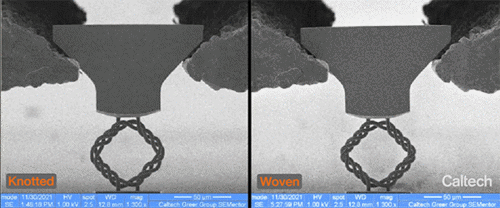Caltech engineers have created a new material made of highly interconnected microscale knots in the latest advancement in nano- and micro-architected materials.

The tensile strength of a material constructed with microscale knots (left), compared to that of a material that lacks knots but is otherwise structurally identical (right). Image Credit: The California Institute of Technology.
The knots make the material far tougher than identically structured but unknotted materials, they absorb more energy, and they can deform more while returning to their original shape undamaged. Because of their durability, potential biocompatibility, and severe deformability, these new knotted materials could find wide applications in biomedicine and aerospace sectors.
The capability to overcome the general trade-off between material deformability and tensile toughness [the ability to be stretched without breaking] offers new ways to design devices that are extremely flexible, durable, and can operate in extreme conditions.
Widianto P. Moestopo, Study Lead Author, Lawrence Livermore National Laboratory
Widianto P. Moestopo is a former Caltech graduate student Widianto P. Moestopo (MS ‘19, PhD ‘22. The study was published on March 8th, 2023, in the journal Science Advances.
Moestopo worked in Julia R. Greer’s lab, the Ruben F. and Donna Mettler Professor of Materials Science, Mechanics, and Medical Engineering, and the Fletcher Jones Foundation. Julia R. Greer is also the Director of the Kavli Nanoscience Institute and a senior author of the Science Advances paper.
Greer is a pioneer in the development of nano-architected materials, or materials whose structure is designed and organized at the nanometer scale and thus exhibit unusual, often surprising properties.
Embarking on understanding how the knots would affect the mechanical response of micro-architected materials was a new out-of-the-box idea. We had done extensive research on studying the mechanical deformation of many other types of micro-textiles, for example, lattices and woven materials. Venturing into the world of knots allowed us to gain deeper insights into the role of friction and energy dissipation and proved to be meaningful.
Julia R. Greer, Director, Kavli Nanoscience Institute
Each knot measures approximately 70 µm in height and width, and each fiber has a radius of approximately 1.7 µm (around one-hundredth the radius of a human hair). While these are not the smallest knots ever made (in 2017, chemists tied a knot made from a single strand of atoms), they are the first time a material made up of numerous knots at this scale has been created.
Furthermore, it demonstrates the potential utility of incorporating these nanoscale knots into a material, such as suturing or tethering in biomedicine.
The knotted polymer materials have tensile toughness that far outperforms unknotted but otherwise similarly structured materials, including those in which individual strands are interwoven rather than knotted. In contrast to unknotted materials, knotted materials absorb 92% more energy and need more than twice the strain to snap when pulled.
The knots were produced in a knotted state rather than tied, utilizing advanced high-resolution 3D lithography capable of producing structures on the nanoscale. The samples described in the Science Advances paper have simple knots—an overhand knot with an extra twist that adds friction to absorb additional energy as the material is stretched. The team intends to investigate materials made from more complex knots in the future.
Moestopo’s fascination with knots stemmed from research he was pursuing in 2020 during the COVID-19 lockdowns.
I came across some works from researchers who are studying the mechanics of physical knots as opposed to knots in a purely mathematical sense. I do not consider myself a climber, a sailor, or a mathematician, but I have tied knots throughout my life, so I thought it was worth trying to insert knots into my designs.
Widianto P. Moestopo, Study Lead Author, Lawrence Livermore National Laboratory
The co-authors of the study are Caltech graduate students Sammy Shaker and Weiting Deng. The study was supported by the National Science Foundation through Moestopo’s Graduate Research Fellowship Program, Caltech’s Clinard Innovation Fund, Greer’s Vannevar Bush Faculty Fellowship, and the Office of Naval Research.
Journal Reference
Moestopo, W. P., et al. (2023) Knots are not for naught: Design, properties, and topology of hierarchical intertwined microarchitected materials. Science Advances. doi.org/10.1126/sciadv.ade6725.